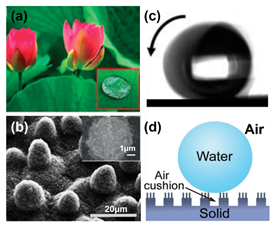In 1997, Wilhelm Barthlott (University of Bonn, Germany) discovered that, the water droplets turned into rolling state while dropping on the lotus surface, taking away the contaminated medium such as dust, so as to maintain a state of spotlessness. It is called "Lotus Effect."
Based on the SEM images, Lotus surface is covered with many randomly distributed papillae with diameters ranging from 5 to 9μm [1]. Moreover, there are also many nano-scale branch-like structures of epicuticular waxes with average diameters of 124.3 ± 3.2 nm on each papilla, constituting a micro-nano hierarchical structure.

Figure 1 (a) Optical image of Lotus leaf. (b) SEM image [1]. (c) The superhydrophobic rolling state of water droplet.
(d) Wettability mechanism (Cassie model).
The micro-scale papillae and nano-scale wax crystal structure on the lotus surface capture air at the groove to form an "air cushion", which generates a negative pressure. Thus, the water droplet is not completely immersed in the surface rough structures during contact with the surface, possessing a high water contact angle and an extremely small rolling angle, preventing the lotus leaf from being wetted by water effectively, thus exhibiting excellent super-hydrophobic self-cleaning phenomenon.
[1] Barthlott W, Neinhuis C. Purity of the sacred lotus, or escape from contamination in biological surfaces. Planta, 1997, 202(1): 1-8.
[2] Feng L, Li S H, Li Y S, et al. Super-Hydrophobic Surfaces: From Natural to Artificial. Advanced Materials, 2002, 14: 1857-1860.
[3] Zhang J H, Wang J M, Zhao Y, et al. How does the leaf margin make the lotus surface dry as the lotus leaf floats on water? Soft Matter, 2008, 4, 2232-2237.
